From the Archives ...
Atlantic Salmon At Large
Atlantic Salmon At Large
Recently Atlantic salmon seems to be a very hot topic amongst local anglers, especially those in the south of the state in the D'Entrecasteaux area. Northern anglers should take a close look at the Tamar as there are opportunities here as well.
The recent "great escape" has provided a perfect opportunity for fresh and saltwater anglers alike to experience some truly memorable sport. Tasmania's pristine, clean and cool waters are the perfect nursery for the Atlantic Salmon and as our local fish farms produce more and more fresh quality seafood it is a fact that there are going to be tangible consequences.
Please check all relevant authorities before fishing - www.ifs.tas.gov.au and dpipwe.tas.gov.au . Don't forget issuu.com/stevenspublishing for years of back issues !
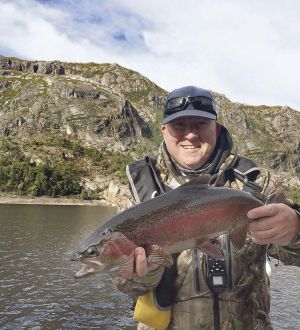 Presented from Issue 110, June 2014
Presented from Issue 110, June 2014
Winter fishing in Tasmania is a funny thing, and as we all know it’s been written about many times over about places to go and what to use. If we look back over the years we will find the fishing has changed greatly year by year because of different things like environmental factors, stocking rates, weather patterns etc. So it may be an apt time to look at Winter fishing again.
Tasmanian anglers from all walks can be a funny bunch and pull the pin on freshwater fishing once Easter passes or because of the closure of most waters, simply ignoring or forgetting about the waters which are open to them year round.
I find the fishing during winter albeit cold can be fantastic. Fishing from May to July can bring some fantastic blue sky days and if you rug up can be rewarded with hungry rainbows trying to fatten up before spawning or browns trying to put condition back on after they have contributed to their population growth. It’s just a matter of picking the right weather, which is something we probably do during the season anyway.
- Written by Stephen Smith - Rubicon Web and Technology Training
- Category: Trout Fishing
- Hits: 4581
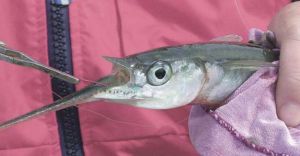 Presented from Issue 110, June 2014
Presented from Issue 110, June 2014
I think ‘Gars on George’ would be a terrific name for a restaurant. In fact, I think that Georges Bay on Tasmania’s lovely east coast is one of the best seafood restaurants I have ever been to. All the great fish are in the bay and they are ever so fresh if you are good enough to catch them. calamari, salmon, mullet, trevally, flathead, leather jackets, bream and whiting are more or less in abundance.
What more could you want? garfish - I say ! I just love them. Both the catching and the eating of them.
Gars have a delicate sweet flesh that eats superbly with a light salad a few lemon wedges and a bottle of Pinot Gris. Could a feed of fish get any better than that?
- Written by Stephen Smith - Rubicon Web and Technology Training
- Category: St Helens
- Hits: 7439
Read more: Gars on George - a trout guide turns garfish addict - Peter Hayes
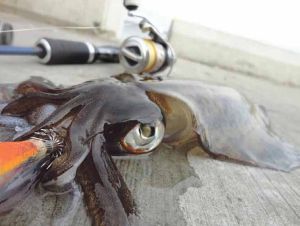 Presented from Issue 109, April 2014
Presented from Issue 109, April 2014
The lower Derwent River and North West Bay can be great places to catch a feed from the shoreline throughout the year. The bays in South Eastern Tasmania boast an impressive head of cockie salmon, sand flathead, squid, wrasse, barracouta well as the odd shark or two, all available to the keen landbased angler. As you move further along the headlands, the species become larger and competent anglers can often take good bags of black-back salmon and nice sized flathead, great fun for the family while catching a feed, all within thirty minutes of home. While this article focus’ on spots thirty minutes from the Kingborough district, the techniques and lures discussed will prove effective all over the state for an array of species.
- Written by Stephen Smith - Rubicon Web and Technology Training
- Category: Derwent River
- Hits: 13537
Read more: Around Kingston - Fun fishing and a good feed - Jason Walker
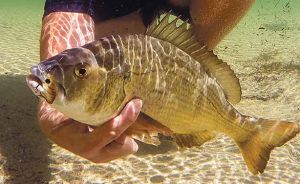 Presented from Issue 109, April 2014
Presented from Issue 109, April 2014
April is an exciting month in Tasmania, the weather becomes much more stable with less wind and as far as our estuaries are concerned there is an abundance of fish species on offer and Georges Bay in St Helens is one of the best. This year will see the annual Tasmanian Family Fishing Festival happening again on the waters of St Helens on Saturday April the 26th. To help budding anglers along I have put together a few hints and tips on where to fish and what to use for the species that you will be targeting. This certainly applies for Georges Bay in April and May, so even if you can’t make the Fishing Festival come down for a few days anyway. Jamie Henderson
- Written by Stephen Smith - Rubicon Web and Technology Training
- Category: St Helens
- Hits: 4667
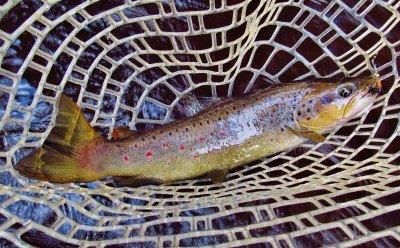 After being out for lunch I thought I would dart of for a few hours to check out a couple of rivers, if either one was running at a reasonable height and clear enough I'd have a go at catching a trout. After a forty five minute drive I was soon bush bashing my way through some heavy scrub to check out the first river which I found to be running too high and a little dirty. A bush back to the car and it was onto the next small stream which I found was a nice dark tannin colour & just the right height to hop in for a spin session.
After being out for lunch I thought I would dart of for a few hours to check out a couple of rivers, if either one was running at a reasonable height and clear enough I'd have a go at catching a trout. After a forty five minute drive I was soon bush bashing my way through some heavy scrub to check out the first river which I found to be running too high and a little dirty. A bush back to the car and it was onto the next small stream which I found was a nice dark tannin colour & just the right height to hop in for a spin session.
- Written by Stephen Smith - Rubicon Web and Technology Training
- Category: Leven River
- Hits: 4934
Read more: Four wild brown trout and one badly damaged hamstring - 09/08/2017
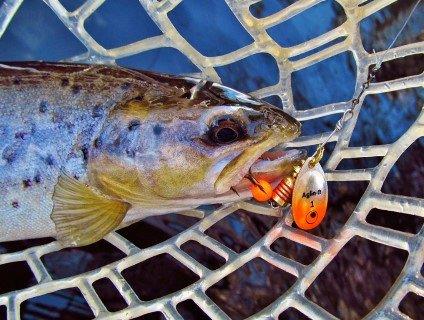 Finally after two very wet, windy days I had a chance to go for my first spin session of the season. This trip was to the Mersey River in the Union Bridge area. I wasn't even thinking of going today even with the fine weather but I thought what the heck go wet a line. Once there I found the river to be running reasonably high and fast with a colour that was like the black coffee I have in the morning. The area I'm fishing today is one that hasn't fished all that well over the past season or two either so I'm not expecting too much this trip. Today is all about getting out and wetting a line for the first time in over three months since the trout season closed. Not that I minded the closure of the season either because it gives me time to get the old body back in some sort of working order for the start of the next one. Each year it gets that little bit tougher on the body for me. With the water still being very cold I thought it was a good time to test out one of the new model Mepps Aglia-e Fluro spinner that I had sent to me to try out on the trout here in Tasmania. I tried several deep long medium flowing stretches of river without a sign of a fish, I was starting to wonder if my trip here was going to be a waste of time. I did try a couple of hard body lures in these long deep runs too before going back to the fluro spinner.
Finally after two very wet, windy days I had a chance to go for my first spin session of the season. This trip was to the Mersey River in the Union Bridge area. I wasn't even thinking of going today even with the fine weather but I thought what the heck go wet a line. Once there I found the river to be running reasonably high and fast with a colour that was like the black coffee I have in the morning. The area I'm fishing today is one that hasn't fished all that well over the past season or two either so I'm not expecting too much this trip. Today is all about getting out and wetting a line for the first time in over three months since the trout season closed. Not that I minded the closure of the season either because it gives me time to get the old body back in some sort of working order for the start of the next one. Each year it gets that little bit tougher on the body for me. With the water still being very cold I thought it was a good time to test out one of the new model Mepps Aglia-e Fluro spinner that I had sent to me to try out on the trout here in Tasmania. I tried several deep long medium flowing stretches of river without a sign of a fish, I was starting to wonder if my trip here was going to be a waste of time. I did try a couple of hard body lures in these long deep runs too before going back to the fluro spinner.
- Written by Stephen Smith - Rubicon Web and Technology Training
- Category: Mersey River
- Hits: 3958
Read more: Three browns to open the 2017-18 trout season. 7/8/2017
Last week, IFS and AAT staff ,with buoys kindly supplied by MAST, set up the recommended outboard motor corridor for Penstock Lagoon and the recommended outboard motor free zone at Little Pine Lagoon. Boat users are asked to familiarize themselves with these arrangements to help protect the fragile weed beds which characterize these shallow lagoons. Details of the arrangements are contained in the 2017/18 Angling Code, on signposting at Penstock Boat Ramp and soon at the ramp at Little Pine. Anglers Alliance has produced a detailed flyer.
- Written by Stephen Smith - Rubicon Web and Technology Training
- Category: IFS, DPIPWE, MAST and Peak Bodies
- Hits: 4812
Read more: Boating recommendations Penstock and Little Pine Lagoons
The commercial and recreational southern calamari and squid fisheries will be closed in two areas off Tasmania's north coast from Friday, 6 October to Sunday, 22 October 2017 inclusive to protect spawning calamari.
- Written by Stephen Smith - Rubicon Web and Technology Training
- Category: IFS, DPIPWE, MAST and Peak Bodies
- Hits: 4104
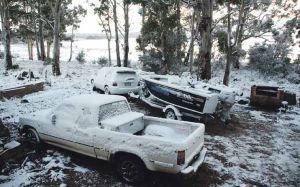 Presented from Issue 109, April 2014
Presented from Issue 109, April 2014
Post-Christmas has me focussed on the Derwent’s big black bream more often than not these days and given my proximity to the river its little wonder that is the case. In a busy time poor world the ease one can achieve a few hours at the drop of a hat it’s a quick release to clear the mind. But come April the true trout angler inside always sees me looking to the highlands for a couple of late season fixes on the trout.
- Written by Stephen Smith - Rubicon Web and Technology Training
- Category: Trout Fishing
- Hits: 5579
Read more: The end is near - Late season trout tactics - Justin Causby
Presented from Issue 109, April 2014
An excerpt from Origins of the Tasmanian Trout JEAN WALKER, Honorary Historian to the Southern Tasmanian Licensed Anglers’ Association produced an accurate and concise account of the fascinating story of the first introduction of trout to Tasmania in 1988.
Tasmania’s Inland Fisheries Service has just republished the booklet to celebrate the sesquicentenary (150 years) since the first tiny trout hatched in the Southern Hemisphere. Here are a few snippets from the booklet Origins of the Tasmanian Trout. Contact IFS on 6261 8050 to find a stockist.
TASMANIA’S early settlers were disappointed by the lack of freshwater angling. The only fish native to the inland waters were Australian grayling, small galaxias and in some rivers blackfish. None offered anglers a challenge in fighting qualities.
Bringing trout from England, 12,000 miles away, s seemed an impossible dream. That the dream, became a reality with perseverance, despite failures and setbacks, in 1864.
- Written by Stephen Smith - Rubicon Web and Technology Training
- Category: Trout Fishing
- Hits: 3659
Read more: Celebrate The Trout - 150 years in Tasmania - First born - 4 May 1864
Subcategories
Current TFBN
Click above for current issue content. The current issue of TFBN is extensive and topical. In Tackle Stores, Newsagents and by subscription.
Delivered to your door for $48 for 2 years (8 issues). To subscribe, send Mike $48 via www.paypal.com.au . (Basic instructions are here) The email is at Contact Us. Your address will be included from PayPal.
Or phone Mike with your c/c handy on 0418129949
Please ensure your details are correct, for Mike to organise delivery.
TFBN Newsletter Sign up Form
Why not submit an article ?
When you have finished for the day, why not have a brag about the ones that didn't get away! Send Mike an article on your fishing (Click here for contact details), and we'll get it published here. Have fun fishing - tasfish.com
Category Descriptions
Here is a list of all of the Article Categories. The number in Brackets, eg (13) is the number of articles. Click on Derwent River and all articles relating to the Derwent will be displayed in the central area.
Articles by Category
-
Rivers (3)
-
Saltwater and Estuary Fishing (149)
-
Kayak Fishing (34)
-
Lakes (1)
-
Great Lake (62)
-
Lake Leake (52)
-
Woods Lake (16)
-
Lake Augusta (11)
-
Huntsman Lake (13)
-
Lake Pedder and Gordon (10)
-
Lake Dulverton (5)
-
Lake Crescent (6)
-
Tooms Lake (10)
-
Lake Mackintosh (2)
-
Lake Barrington (5)
-
Little Lake (8)
-
Meadowbank Lake (5)
-
Lake King William (7)
-
Lake St Clair (2)
-
Western Lakes (12)
-
Arthurs Lake (35)
-
Lake Echo (7)
-
Four Springs (54)
-
Lake Sorell (7)
-
Lake Burbury (6)
-
Other Lakes (57)
-
Brushy Lagoon (18)
-
Little Pine Lagoon (5)
-
Penstock Lagoon (16)
-
Brumbys Creek (7)
-
-
Events (48)
-
Estuary Fishing (0)
-
Coastal Catches (46)
-
Super Trawler (46)
-
IFS, DPIPWE, MAST and Peak Bodies (435)
-
Commercial Interests (98)
-
Other (24)
-
TFBN Back Issues (8)
-
Fly Fishing (67)
-
Trout Fishing (250)
-
Meteorology and Weather (8)
-
Jan’s Flies (50)
-
Tuna Fishing and other Game Fishing (86)
-
Cooking Fish (19)
-
Fishing Information (1)
-
Fishing Books (8)
-
Videos (5)
-
Tackle, Boats and other Equipment (146)
-
World Fly Fishing Championship 2019 (2)
Popular Tags
windyty.com
Visit https://www.windyty.com/
Rubicon Web and Technology Training
Hello everyone, I thought it would be a good time to introduce myself.
My name is Stephen Smith and I have been managing the website tasfish.com since May 2009.
It has been an epic journey of learning and discovery and I am indebted to Mike Stevens for his help, support and patience.
I am developing a new venture Rubicon Web and Technology Training ( www.rwtt.com.au ). The focus is two part, to develop websites for individuals and small business and to train people to effectively use technology in their everyday lives.
Please contact me via www.rwtt.com.au/contact-me/ for further information - Stephen Smith.
From the Archives ... (last chance)
Trout tips - from tackle shops
Presented from Issue 105, August 2013
We did a bit of a runaround Tasmania’s tackle stores to see what their tips for the first month or so of the tackle season were. We asked what the top three places to fish were, plus lures, flies, baits and a few other things.
Here is a rundown on their answers Whenever, and wherever you fish - anywhere, or for any fish in the world - ask the locals and especially ask at the local tackle store. They know what was caught today, yesterday and on what.

 Source http://dpipwe.tas.gov.au/sea-fishing-aquaculture/sustainable-fisheries-management/fisheries-management-strategies/north-coast-calamari-closure
Source http://dpipwe.tas.gov.au/sea-fishing-aquaculture/sustainable-fisheries-management/fisheries-management-strategies/north-coast-calamari-closure

